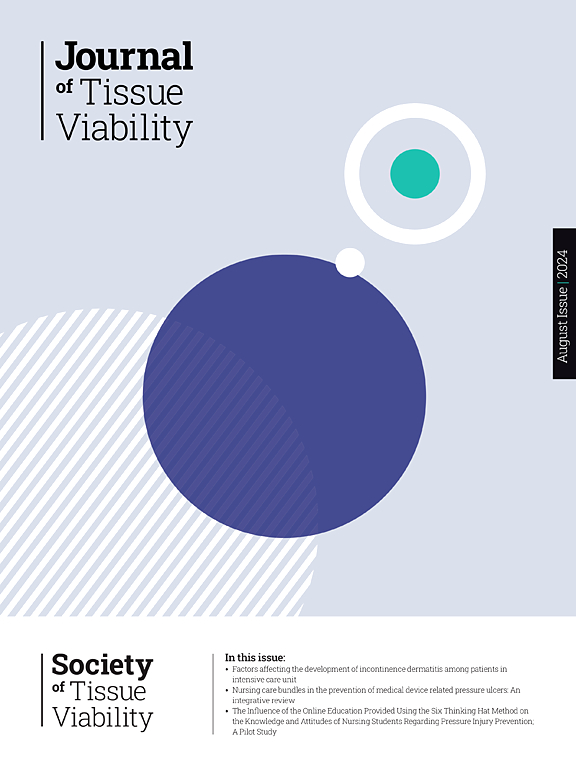Cognitive gaps and educational needs in foot self-care among patients with diabetic foot from a health literacy perspective: A qualitative study
IF 2.4
3区 医学
Q2 DERMATOLOGY
引用次数: 0
Abstract
Objective
From both the healthcare provider and patient perspectives, this study explores the specific cognitive gaps and educational needs related to health literacy in the self-care behaviors of patients with Wagner grade 0 diabetic foot (DF), to provide a basis for optimizing intervention strategies.
Method
This study adopted a descriptive phenomenological qualitative research design. Based on the International Working Group on the Diabetic Foot (IWGDF) guidelines for foot ulcer prevention, we constructed a guideline for proper foot self-care behaviors. We conducted semi-structured interviews based on this guideline with 13 healthcare professionals with varying levels of clinical experience and 6 patients with Wagner grade 0 diabetic foot (DF). The data were analyzed using Colaizzi's 7-step method to extract the core themes.
Results
We extracted three core themes: (1) Deficits in Knowledge and Risk Perception (fragmented understanding of foot pathology, impaired causal reasoning); (2) Limitations in Self-care Ability and Social Support (physical limitations, inadequate social support); (3) Failures in the Communication and Information Environment (lack of terminology comprehension, unmet needs and inaccessible resources, spread of misinformation and desensitization to risks).
Conclusion
The self-care difficulties of Wagner stage 0 DF patients stem from a multi-dimensional deficit in health literacy: a disconnect between risk perception and the understanding of the behavioral cause-and-effect chain at the cognitive level, behavioral capabilities restricted by both physical and social factors, a communication gap due to a lack of terminology and resource discontinuity, and the vicious cycle of misinformation and risk insensitivity. This study moves beyond the previous focus solely on 'knowledge deficiency,' proposing the key roles of 'causal health literacy deficiency' and 'systemic ecological dysfunction.' It calls for a paradigm shift in health literacy education from imparting 'fragmented knowledge' to fostering 'causal internalization,' and from emphasizing 'individual responsibility' to enabling 'systemic empowerment,' providing a basis for the precise design of educational strategies centered on 'causal logic and system support.'
健康素养视角下糖尿病足患者足部自我护理的认知差距和教育需求:一项定性研究
目的从医护人员和患者的角度,探讨Wagner 0级糖尿病足(DF)患者自我护理行为中与健康素养相关的具体认知差距和教育需求,为优化干预策略提供依据。方法本研究采用描述现象学定性研究设计。根据国际糖尿病足工作组(IWGDF)的足部溃疡预防指南,我们构建了正确的足部自我保健行为指南。根据该指南,我们对13名具有不同临床经验的医疗保健专业人员和6名Wagner 0级糖尿病足(DF)患者进行了半结构化访谈。使用Colaizzi的7步法对数据进行分析,提取核心主题。结果我们提取了三个核心主题:(1)知识和风险感知缺陷(对足部病理的理解碎片化,因果推理受损);(2)自我照顾能力和社会支持方面的限制(身体限制、社会支持不足);(3)传播和信息环境的失败(缺乏术语理解,需求未得到满足和资源难以获得,错误信息的传播和对风险的不敏感)。结论Wagner期DF患者的自我护理困难源于健康素养的多维缺失:认知层面的风险认知与行为因果链理解脱节,生理和社会因素限制行为能力,缺乏术语和资源不连续导致沟通缺口,错误信息和风险不敏感的恶性循环。这项研究超越了以往仅仅关注“知识缺失”的观点,提出了“因果健康素养缺失”和“系统性生态功能障碍”的关键作用。它呼吁在卫生素养教育中进行范式转变,从传授“碎片化知识”到促进“因果内化”,从强调“个人责任”到实现“系统赋权”,为精确设计以“因果逻辑和系统支持”为中心的教育战略提供基础。
本文章由计算机程序翻译,如有差异,请以英文原文为准。
求助全文
约1分钟内获得全文
求助全文
来源期刊

Journal of tissue viability
DERMATOLOGY-NURSING
CiteScore
3.80
自引率
16.00%
发文量
110
审稿时长
>12 weeks
期刊介绍:
The Journal of Tissue Viability is the official publication of the Tissue Viability Society and is a quarterly journal concerned with all aspects of the occurrence and treatment of wounds, ulcers and pressure sores including patient care, pain, nutrition, wound healing, research, prevention, mobility, social problems and management.
The Journal particularly encourages papers covering skin and skin wounds but will consider articles that discuss injury in any tissue. Articles that stress the multi-professional nature of tissue viability are especially welcome. We seek to encourage new authors as well as well-established contributors to the field - one aim of the journal is to enable all participants in tissue viability to share information with colleagues.
 求助内容:
求助内容: 应助结果提醒方式:
应助结果提醒方式:


